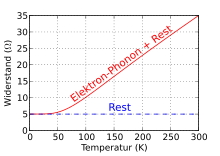Residual resistance ratio
The residual resistance ratio (often just RRR or RRR for Residual Resistance Ratio) describes the ratio of the resistance of a material at an absolute temperature of 293 Kelvin to the resistance of a material at very low temperatures, around 4 K, where there is no longer any contribution from the thermal lattice oscillation is expected (residual resistance).
The size of the residual resistance ratio is a measure of the purity of a material. The larger the ratio, the fewer imperfections the material has. At high temperatures, electrons scatter on phonons in addition to the solid impurities inherent in the material . Since the phonons, in contrast to the solid impurities, disappear at low temperatures, the ratio of the two resistances (with and without phonons) provides information about the proportion of solid impurities.
In the case of superconductors, the resistance just above the transition temperature from the superconducting to the normally conducting state is usually used as the residual resistance. In the superconducting state, only the resistance of the measuring lines remains, which, if present, can be used for offset correction.
Pure aluminum has z. B. a residual resistance ratio of RRR = 20,000. Typical values for thin wires are on the order of about 20.
